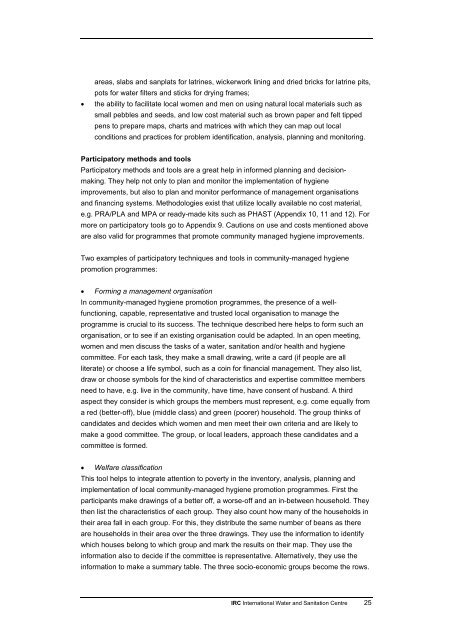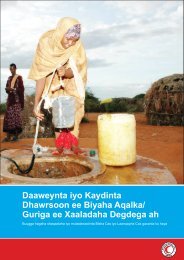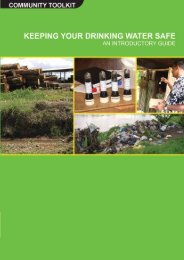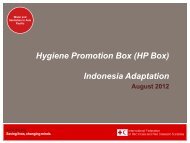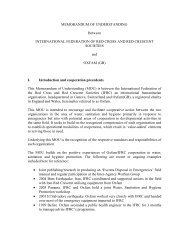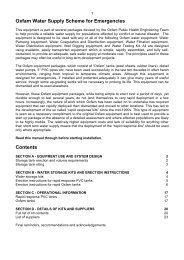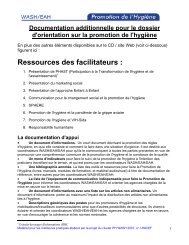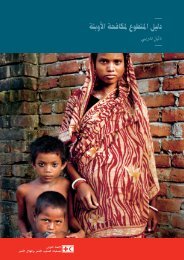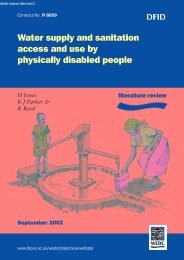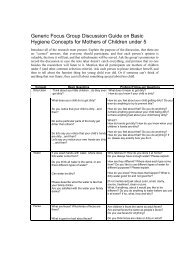Hygiene Promotion - IRC International Water and Sanitation Centre
Hygiene Promotion - IRC International Water and Sanitation Centre
Hygiene Promotion - IRC International Water and Sanitation Centre
Create successful ePaper yourself
Turn your PDF publications into a flip-book with our unique Google optimized e-Paper software.
areas, slabs <strong>and</strong> sanplats for latrines, wickerwork lining <strong>and</strong> dried bricks for latrine pits,pots for water filters <strong>and</strong> sticks for drying frames;• the ability to facilitate local women <strong>and</strong> men on using natural local materials such assmall pebbles <strong>and</strong> seeds, <strong>and</strong> low cost material such as brown paper <strong>and</strong> felt tippedpens to prepare maps, charts <strong>and</strong> matrices with which they can map out localconditions <strong>and</strong> practices for problem identification, analysis, planning <strong>and</strong> monitoring.Participatory methods <strong>and</strong> toolsParticipatory methods <strong>and</strong> tools are a great help in informed planning <strong>and</strong> decisionmaking.They help not only to plan <strong>and</strong> monitor the implementation of hygieneimprovements, but also to plan <strong>and</strong> monitor performance of management organisations<strong>and</strong> financing systems. Methodologies exist that utilize locally available no cost material,e.g. PRA/PLA <strong>and</strong> MPA or ready-made kits such as PHAST (Appendix 10, 11 <strong>and</strong> 12). Formore on participatory tools go to Appendix 9. Cautions on use <strong>and</strong> costs mentioned aboveare also valid for programmes that promote community managed hygiene improvements.Two examples of participatory techniques <strong>and</strong> tools in community-managed hygienepromotion programmes:• Forming a management organisationIn community-managed hygiene promotion programmes, the presence of a wellfunctioning,capable, representative <strong>and</strong> trusted local organisation to manage theprogramme is crucial to its success. The technique described here helps to form such anorganisation, or to see if an existing organisation could be adapted. In an open meeting,women <strong>and</strong> men discuss the tasks of a water, sanitation <strong>and</strong>/or health <strong>and</strong> hygienecommittee. For each task, they make a small drawing, write a card (if people are allliterate) or choose a life symbol, such as a coin for financial management. They also list,draw or choose symbols for the kind of characteristics <strong>and</strong> expertise committee membersneed to have, e.g. live in the community, have time, have consent of husb<strong>and</strong>. A thirdaspect they consider is which groups the members must represent, e.g. come equally froma red (better-off), blue (middle class) <strong>and</strong> green (poorer) household. The group thinks ofc<strong>and</strong>idates <strong>and</strong> decides which women <strong>and</strong> men meet their own criteria <strong>and</strong> are likely tomake a good committee. The group, or local leaders, approach these c<strong>and</strong>idates <strong>and</strong> acommittee is formed.• Welfare classificationThis tool helps to integrate attention to poverty in the inventory, analysis, planning <strong>and</strong>implementation of local community-managed hygiene promotion programmes. First theparticipants make drawings of a better off, a worse-off <strong>and</strong> an in-between household. Theythen list the characteristics of each group. They also count how many of the households intheir area fall in each group. For this, they distribute the same number of beans as thereare households in their area over the three drawings. They use the information to identifywhich houses belong to which group <strong>and</strong> mark the results on their map. They use theinformation also to decide if the committee is representative. Alternatively, they use theinformation to make a summary table. The three socio-economic groups become the rows.<strong>IRC</strong> <strong>International</strong> <strong>Water</strong> <strong>and</strong> <strong>Sanitation</strong> <strong>Centre</strong> 25


